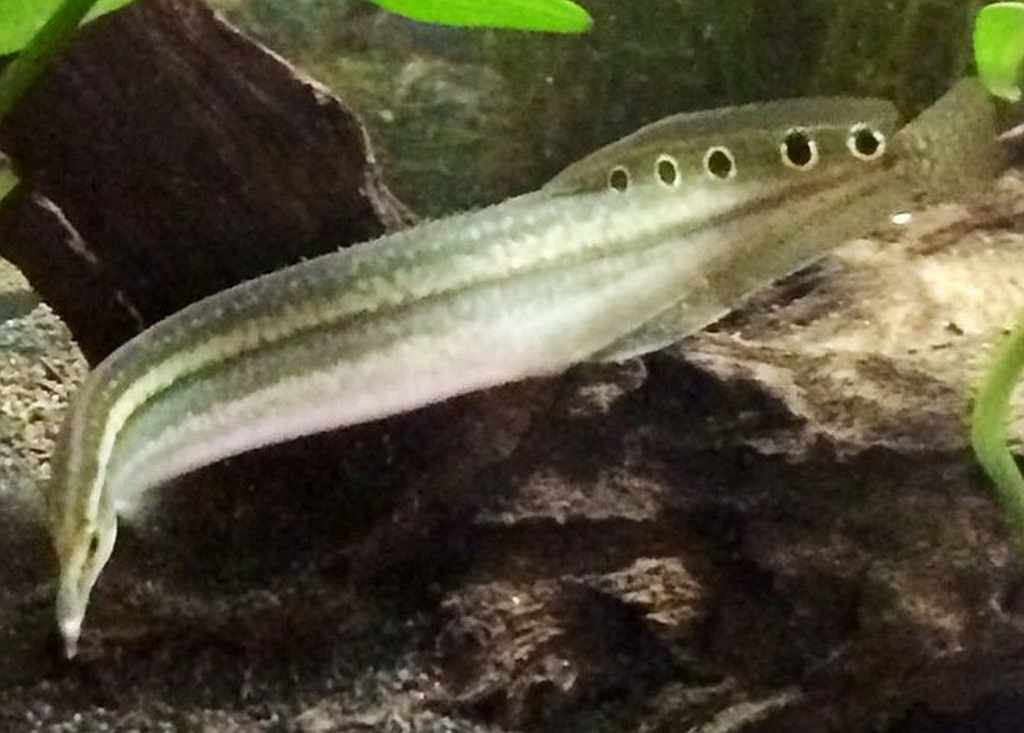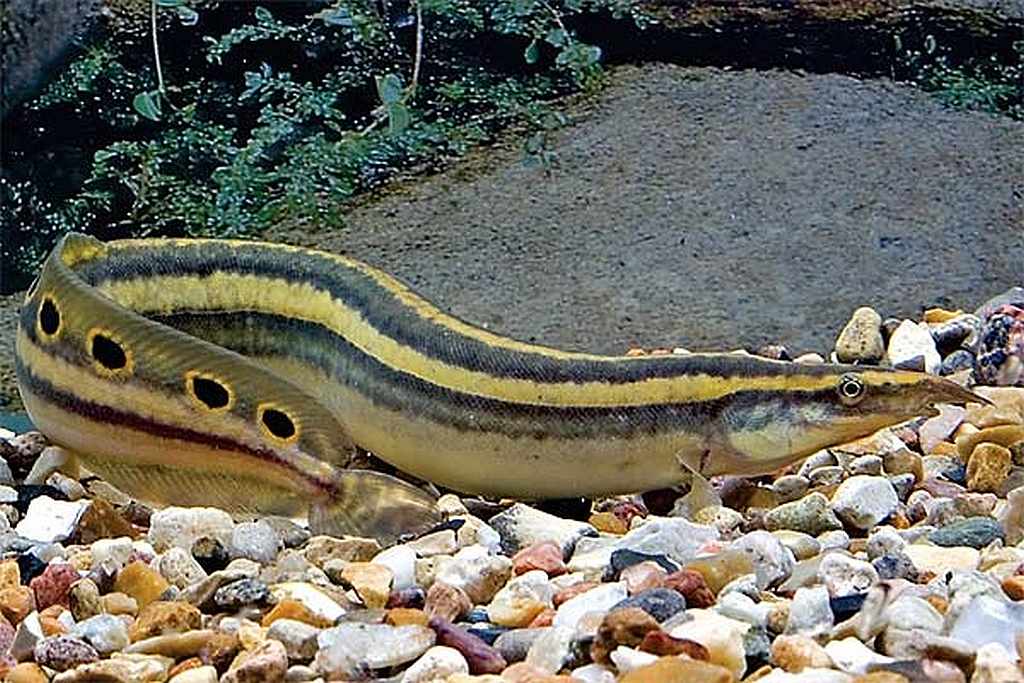The Peacock Eel (Macrognathus siamensis) is found in the Mekong, Chao Phraya, Maeklong, river basins in Peninsular and Southeast Thailand. They are also commonly known to tropical fish keeping enthusiasts as the Spot-Finned Spiny Eel, Peacock Spiny Eel, Striped Peacock Eel, or Siamese Spiny Eel.
Depending on where they are collected from, Peacock Eels are a light brown color with a thin pale yellow strip that runs from the eye to the base of the tail. They generally have three to six eye spots along the upper rear portion of the body that run along the base of the dorsal fin which lends to their common name “Peacock Eel”.
Peacock Eels have an elongated body, a pointed snout, with both the dorsal and anal fins extending back to their relatively small caudal fin. Although females are believed to have fuller bodies, it is virtually impossible to distinguish between sexes, which is probably why they have not been successfully bred in an aquarium environment.
Peacock Eels are a largely nocturnal species that inhabit slow moving, thickly vegetated areas of rivers and still waters of flooded fields. Except for their heads, they bury themselves into the sandy or silty substrate during daylight hours and come out at night to feed on worms, insect larvae, and other small crustaceans.
Because Peacock Eels are sensitive to changes in water quality, they are generally suggested for more experienced tropical fish keeping enthusiasts. In an aquarium environment, they are usually quite shy and take a couple of weeks before they begin to eat on a regular basis. They require pristine water conditions and are sensitive to parasites, fungal infections, and the copper based medications used to cure these diseases.
Peacock Eels do best in a well oxygenated 35 gallon or larger tank with soft, to medium hard water. Because under gravel filters increase the oxygen content and reduce the amount of waste in the tank, many tropical fish keeping enthusiasts prefer using them when housing Peacock Eels.
Although Peacock Eels do well in a tank with a medium to small grain gravel substrate over an under gravel filter; a sandy substrate with a canister filter that provides a water turnover of 10 to 15 times per hour is preferable. Regardless of which filtration system you use, a tight fitting lid is mandatory for these escape artists.
Since Peacock Eels are more active in a dimly lit aquarium, it’s a good idea to provide them with plenty of floating plants to diffuse the light in the tank. They enjoy burrowing in the bottom, so a sand or fine gravel substrate is recommended along with lots of rocky caves, driftwood
roots, and potted plants for them to hide among. Many tropical fish keeping enthusiasts just place a piece of PVC pipe into their tank for them to retreat into, in lieu of a rocky cave.
If you give them multiple places for them to hide, they feel safer and be more visible during daylight hours. Macrognathus siamensis is a shy, peaceful species that gets along well in a community tank setting with a wide variety of fish larger than themselves including their own kind, providing they are of the same approximate size.
Peacock Eels are spiny eels, and although they have not been bred in an aquarium environment, it is presumed that they breed in the same manner as other spiny eels. Emulating the flooding conditions encountered during the rainy season in their natural habitat is believed to stimulate breeding behavior. Feeding a pair higher quality live foods and providing them with a continuous influx of clean water is also believed to promote breeding behavior.
If a pair decides to spawn, they will exhibit a type of courtship ritual where they chase each other around in circles until breeding actually occurs. Their sticky eggs are deposited among floating plants and will normally hatch withing 3 or 4 days. The fry are free swimming in a few more days and can be fed baby brine shrimp. Like their parents, the fry are susceptible to fungal infections and will require frequent regular water changes. A layer of Indian Almond Leaves in the breeding tank will aid considerably in the prevention of disease.
Peacock Eels are nocturnal carnivores that feed on insect larvae, crustaceans, small fishes and worms. In an aquarium environment, all spiny eels prefer a diet of live or freshly frozen foods such as brine shrimp, earthworms, black worms, small guppies or bloodworms.
Although some spiny eels can be trained to eat freeze dried brine shrimp, Tubifex or bloodworms, don’t count on it when you purchase one. Feed Peacock eels after you turn off the lights on their aquarium and only once or twice a week. Many will only accept food once every two or three weeks.
The Peacock Eel is commonly available to tropical fish keeping enthusiasts online and in the aquarium trade at reasonable prices.
Minimum Tank Size: 35 gallons
Care Level: Moderate
Temperament: Shy, Peaceful
Aquarium Hardiness: Moderately Hardy
Water Conditions: 73-82° F, 6-25 dGH, pH 6.0-8.0
Max. Size: 11.9″
Color Form: Brown, Tan
Diet: Carnivore
Compatibility: Community
Origin: Southeast Asia
Family: Mastacembelidae
Lifespan: 18 years
Aquarist Experience Level: Intermediate




